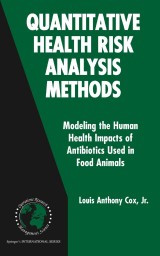Details

Quantitative Health Risk Analysis Methods
Modeling the Human Health Impacts of Antibiotics Used in Food AnimalsInternational Series in Operations Research & Management Science, Band 82
|
96,29 € |
|
| Verlag: | Springer |
| Format: | |
| Veröffentl.: | 17.03.2006 |
| ISBN/EAN: | 9780387261188 |
| Sprache: | englisch |
| Anzahl Seiten: | 354 |
Dieses eBook enthält ein Wasserzeichen.
Beschreibungen
This book grew out of an effort to salvage a potentially useful idea for greatly simplifying traditional quantitative risk assessments of the human health consequences of using antibiotics in food animals. In 2001, the United States FDA’s Center for Veterinary Medicine (CVM) (FDA-CVM, 2001) published a risk assessment model for potential adverse human health consequences of using a certain class of antibiotics, fluoroquinolones, to treat flocks of chickens with fatal respiratory disease caused by infectious bacteria. CVM’s concern was that fluoroquinolones are also used in human medicine, raising the possibility that fluoroquinolone-resistant strains of bacteria selected by use of fluoroquinolones in chickens might infect humans and then prove resistant to treatment with human medicines in the same class of antibiotics, such as ciprofloxacin. As a foundation for its risk assessment model, CVM proposed a dramatically simple approach that skipped many of the steps in traditional risk assessment. The basic idea was to assume that human health risks were directly proportional to some suitably defined exposure metric. In symbols: Risk = K × Exposure, where “Exposure” would be defined in terms of a metric such as total production of chicken contaminated with fluoroquinolone-resistant bacteria that might cause human illnesses, and “Risk” would describe the expected number of cases per year of human illness due to fluoroquinolone-resistant bacterial infections caused by chicken and treated with fluoroquinolones.
Qualitative and Quantitative Risk Analysis.- Risk Analysis: Goals and Methods.- Hazard Identification.- Exposure Assessment.- Dose-Response Modeling and Risk Characterization.- Human Health Risks from Virginiamycin: A Case Study.- Dynamic Modeling and Uncertainty Analysis.- Potential Human Health Benefits of Animal Antibiotics.
<P>"Antibiotic use in animals has aroused sharply polarised views and public anxiety about potential human health risks, stimulated by lack of any objective standard to help navigate among conflicting studies and perceptions. Tony Cox's <STRONG>Quantitative Health Risk Analysis Methods</STRONG> represents a giant leap forward, helping to provide such a standard. Notable improvements and increased scientific rigor in public health risk assessment and risk management can be expected from the insightful approaches lucidly described in this book. I will be recommending it enthusiastically to all students of public health." <EM>Stephen Page, University of Sydney Veterinary Public Health Management Program</EM></P>
<P>"Tony Cox has been a true pioneer in this previously untouched niche area of applied risk assessment. This book should be highly instructive to those interested in attempting to model potential human health risks of antimicrobial resistance from complex food exposure pathways." <EM>Rich Carnevale, Animal Health Institute</EM></P>
<P>"Tony Cox has been a true pioneer in this previously untouched niche area of applied risk assessment. This book should be highly instructive to those interested in attempting to model potential human health risks of antimicrobial resistance from complex food exposure pathways." <EM>Rich Carnevale, Animal Health Institute</EM></P>
A thorough analytical treatment and exposition of some of the main quantitative methods that can be used to assess the risk of human health consequences of using antibiotics in food animals. The 'probable human health consequences of withdrawing or restricting current animal antibiotic use' is the question which is applied to each chapter The major goal of this book is to provide and illustrate methods for quantitative risk assessment and for comparing alternative risk management actions, given realistic limitations on scientific knowledge and available data. Some of the steps covered are hazard identification, exposure assessment, dose-response modeling, and risk characterization, including uncertainty and sensitivity analyses
<P>Worldwide health care problems are finding growing application in Operations Research. This monograph covers a range of modeling and methodological issues including environmental, experimental, simulation, and mathematical modeling approaches. The author is one of the leading research scholars in the field. His work on health risk modeling will be synthesized along with the work of others on modeling human health risks. The main goal is to provide and illustrate methods for quantitative risk assessment and for comparing alternative risk management actions, given realistic limitations on scientific knowledge and available data. Some of the steps covered are hazard identification, exposure assessment, dose-response modeling, and risk characterization, including uncertainty and sensitivity analyses.</P>

















